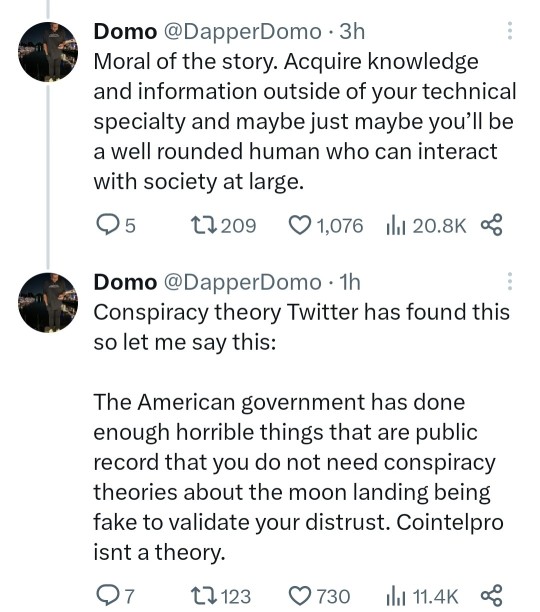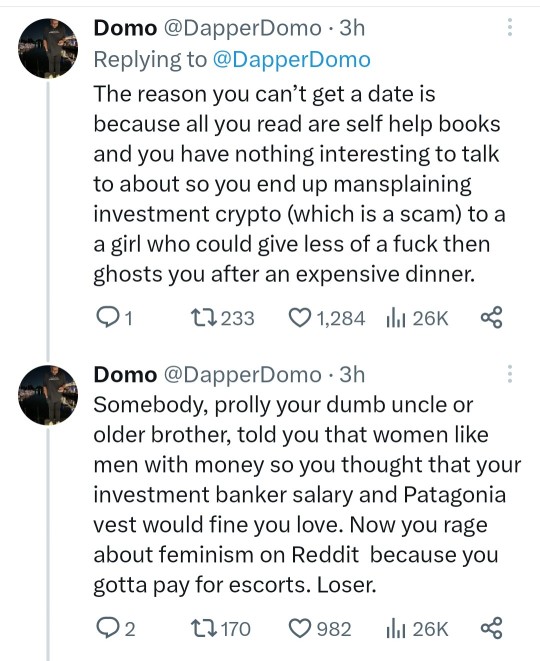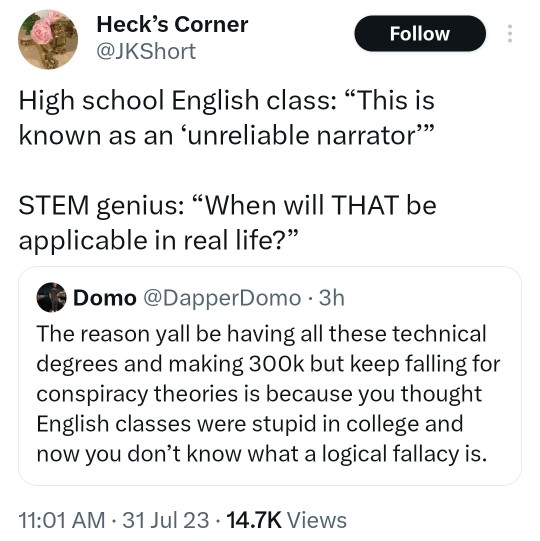Text
“what’s the song of the summer” ?? it’s DANCING IN THE DARK by bruce springsteen for the 40th year in a row
6K notes
·
View notes
Text
I am by no means suggesting that a food critic can't write fiction but here's a quote from his review of the first Popeye's to open in Scotland, for context on his writing generally:
Isn't fried chicken, in a weird way, a form of race revenge? The thrusting young economies of West Africa now must surely look at a KFC bargain bucket and high-five themselves that their ancestors had the forethought, all those years ago, to provide the means by which white culture would one day poison itself to death.
His Wikipedia page has a controversies section that's full of what a clown shoes dickhead he is.



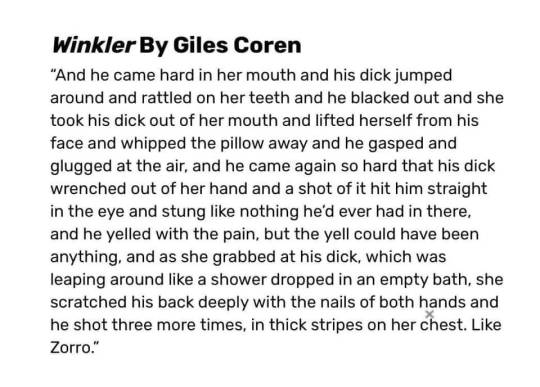
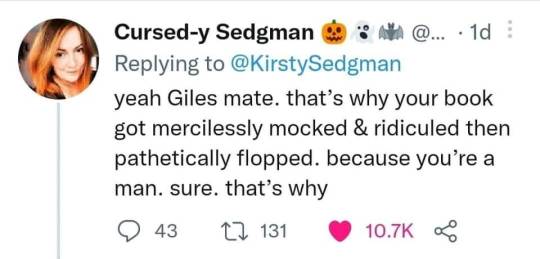
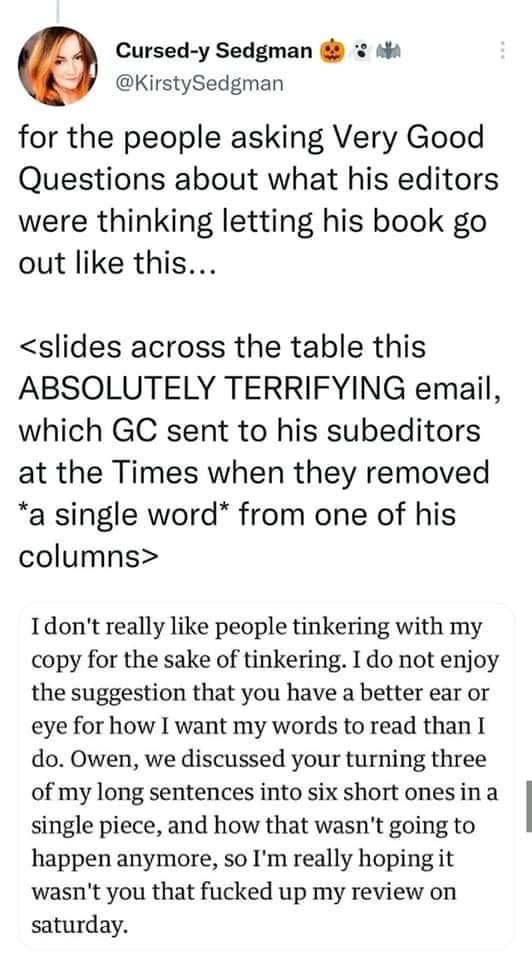
108K notes
·
View notes
Text
When people get a little too gung-ho about-
wait. cancel post. gung-ho cannot be English. where did that phrase come from? China?
ok, yes. gōnghé, which is…an abbreviation for “industrial cooperative”? Like it was just a term for a worker-run organization? A specific U.S. marine stationed in China interpreted it as a motivational slogan about teamwork, and as a commander he got his whole battalion using it, and other U.S. marines found those guys so exhausting that it migrated into English slang with the meaning “overly enthusiastic”.
That’s…wild. What was I talking about?
19K notes
·
View notes
Text
Nick Mohammed scuttling around on the floor with a camp bed tied to his back looking like an even sadder Gregor Samsa
58 notes
·
View notes
Text
The one bizarre thing to me about textiles is that warp-weighted weaving is at least 6500 years old, but our oldest knitted artifacts are only ~1000 years old, and crochet 200 years old. Even though you need less equipment to knit (two sticks) or crochet (one hook) compared to warp-weighted weaving (frame, loom weights, batting, heddles). Why the big gaps between these inventions? And why did each one appear and spread when it did?
2K notes
·
View notes
Text
Shocking how many people don’t know that hens lay non-fertilized eggs and think the yolk they’re eating is a baby chicken
240K notes
·
View notes
Text
Bit telling that for years and years evangelical religious extremists have been allowed on university campuses with their bullhorns and horrific imagery where they harass students into physical altercations and when students complain to the university’s administration they just shrug their shoulders citing freedom of speech but when those same tuition-paying students start protesting against war and genocide they call SWAT
25K notes
·
View notes
Text
I mean he usually solves it but he's never normal about it.
One thing I love about the X-Files is that people just keep coming to Mulder for help. Like, it's well known that this man believes in extraterrestrials etc, but people will bring a difficult case to him like they're hoping that just this once, he will be normal enough to help them solve the case. And he never is!
43 notes
·
View notes
Text
I find this idea really resonant with respect to my girl Fanny Price in Mansfield Park. Fanny is both born into and taken in by families who value her only insofar as she is useful to them, often to the point of neglecting her physical health and always without reference to her emotional health. She holds on to her moral centre as a way of knowing who she is, but she lives with an often crippling level of anxiety. It's only Edmund who ever views her as someone with an inner life and emotional needs, or offers her comfort and support. Is it any wonder she loves him? Henry Crawford comes to understand Fanny as someone who is a worthwhile match, but even after seeing her at home in Portsmouth being actively neglected by the Prices, never truly gets her on an emotional level (which is why you will never see me shipping Henry-Fanny). Only Edmund ever takes the time to try and see that part of her and honours her resilience and steadiness of character. The irony of course is that both Mary and Henry Crawford grew up in a fucked up parenting environment that left them both with emotional gaps you could drive a barouche box through.
I would put Anne Elliot in this category as well, though she does at least have the loving support of Lady Russell. I don't think it's surprising that adaptations really struggle to get these two characters right.
After my presentation of the Secret Garden and CEN paper, someone in the audience asked about applying the lens of CEN to other children's book from the same era. I thought about it afterward, and the best example that came to mind was Anne of Green Gables.
Anne Shirley, before her arrival at Green Gables, has experienced CEN. It has played out in a much different way for her than it does for Mary and Colin in TSG, due to differences in social class, but the principle has been the same. As an orphan raised in homes that viewed her as an inconvenience and a sort of unpaid servant, she has never had an adult in her life who prioritized her emotional well-being, who took the time to be kind to her, to listen to her, to teach her how to function in the world beyond basic survival. She is aware that no one wants her after her parents' death, and she is made to feel guilty by her caretakers for having the audacity to exist and need to be "brought up by hand." It's difficult for Anne to even talk about these experiences when Marilla asks her. She's relieved to get relating them over with, because "Evidently she did not like talking about her experiences in a world that had not wanted her."
And then there's this exchange:
“Were those women—Mrs. Thomas and Mrs. Hammond—good to you?” asked Marilla, looking at Anne out of the corner of her eye.
“O-o-o-h,” faltered Anne. Her sensitive little face suddenly flushed scarlet and embarrassment sat on her brow. “Oh, they meant to be—I know they meant to be just as good and kind as possible. And when people mean to be good to you, you don’t mind very much when they’re not quite—always. They had a good deal to worry them, you know. It’s a very trying to have a drunken husband, you see; and it must be very trying to have twins three times in succession, don’t you think? But I feel sure they meant to be good to me.”
Anne has clearly been mistreated, but she's describing--and pointedly not describing--suggests less of aggression and physical harm and more of something missing, an emptiness, a lack of love--CEN. Likewise, she herself exhibits some signs that can be associated with this type of maltreatment. Difficulty with emotional regulation, attachment problems, extreme sensitivity to rejection, negativity toward herself, excessively immersing herself in imagination (a mild dissociative tendency), anxiety around social situations (regarding how to behave correctly and whether people will like her), etc.
And in a way, the entire first book of the series deals with how she finds healing from her past of CEN, through gaining the love and acceptance of her new family, of friends, of an entire community.
From what little I know of L. M. Montgomery's life, CEN was likely a factor in her own upbringing, and it repeatedly features in her novels (The Blue Castle and Jane of Lantern Hill, for instance, in particular feature heroines who have experienced CEN) with poignancy. Montgomery paints moving portraits of how badly children can be scarred by a lack of love and affirmation.
Anyway, situating Anne's backstory as rooted in CEN helped me put my finger on one of the reasons that I felt that the recent series Anne With an E--at least the first season, which is all I've seen--misunderstood the nature of Anne's past. In this version, we see flashbacks to Anne's past, in which she is being viciously bullied by other children for her talkativeness and imagination. They even go so far as to stuff a mouse into her mouth, and the show suggests that Anne has PTSD as a result of this kind of treatment.
And yeah, Anne's childhood in the book isn't great and clearly has hurt her deeply, but this interpretation felt off to me. What Anne has to say--and not say--about her past in the book suggests not that she was targeted as an object of others' aggression but that she was disregarded. No one was giving her a second thought. That's not as dramatic and shocking as vicious bullying, but it's another, more subtle, insidious kind of maltreatment, just as hurtful in its way but harder to pin down. It's easy to portray a quick, sensational scene of our protagonist being obviously, overtly, grandiosely mistreated, but how do you show the gradual piling up of years' and years' of being treated like you don't matter? All the tiny incidents that chip away at one's sense of self-worth? The building of a worldview in which you must earn love and acceptance but somehow you can never manage it and of course it's your own fault?
And I'm reminded how recent adaptations and retellings of TSG shift the narrative toward grief, which is easy to dramatize, big and impressive and full of obvious pathos. It's an easy way out of depicting a subtler kind of suffering, and the same way, Anne With an E replaces Anne's CEN with bullying and PTSD. There is a place for such stories, but Anne's isn't one of them. It's almost as if there's an inability to understand or a reluctance to depict any kind of suffering that isn't big and grand and shocking. There are many ways that people can be deeply hurt, and it doesn't always look like a major traumatic event that's easy to pinpoint. Sometimes the hurt isn't a tidal wave that engulfs in a single devastating event; it's a slow drip that erodes oneself away little by little. That's closer to what is depicted for Anne, and Montgomery's other protagonists who have experienced CEN, and it's important to recognize what exactly is going on because this sort of thing still happens every day in the real world, in many forms, and it needs to be seen and combatted. And seeing this form of maltreatment play out in literature helps us recognize it and empathize with and reach out to those whom it has impacted--or possibly even to identify it in our own histories and search for our own healing.
33 notes
·
View notes
Photo
I think it's worth noting that the sewing machine wasn't patented until the mid 19th century so this person sewed the entire cat outfit by hand.

The tailors at Colonial Williamsburg made a suit for their cat
48K notes
·
View notes
Text
My boyfriend is trying to explain cricket to me again. “He’s only got two balls to make 48 runs”, he says. The camera focuses on a man. Underneath him it says LEFT ARM FAST MEDIUM. A ball flies into the stands and presumably fractures someone’s skull. “There’s a free six”, my boyfriend says. 348 SIXES says the screen. A child in the audience waves a sign referencing Weet-Bix
117K notes
·
View notes
Text
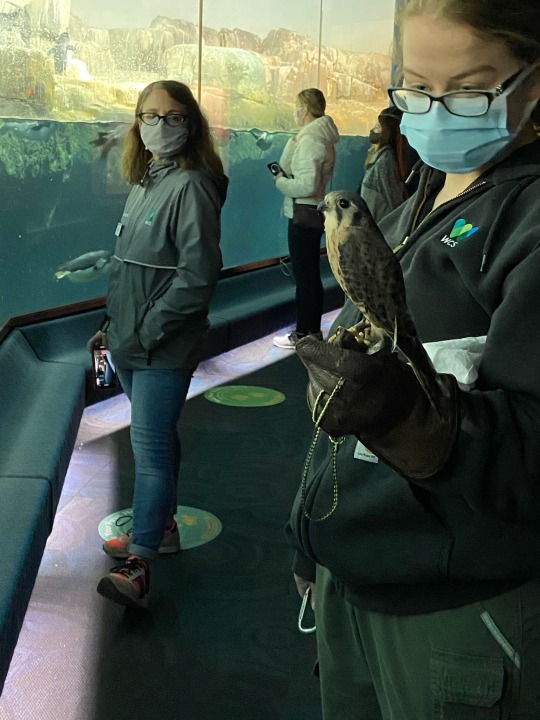
I almost forgot to mention: this woman came into the penguin enclosure with a KESTREL??? I said “oh my god is that an American Kestrel?” and she said “Yes! She was outside doing raptor education for the kids, but she doesn’t like to get rained on.”
156K notes
·
View notes
Text
Another novelist among the friends of the family was Jane’s favourite, Frances Burney, who had written Evelina and Cecilia, and who now was publishing her novel Camilla by subscription. A bit like crowd-funding today, subscribers got the privilege of having their names listed in the front of the finished book. The list for Camilla reads rather like a sisterhood of Georgian female novelists, because so many of them supported their fellow author. It includes a Mrs Radcliffe, and Miss Edgeworth (author of Belinda) and indeed a nineteen-year-old ‘Miss J. Austen of Steventon’, whose guinea must have been paid for her by her father.
Lucy Worsley, Jane Austen At Home
18 notes
·
View notes

